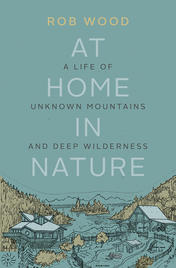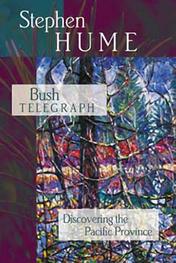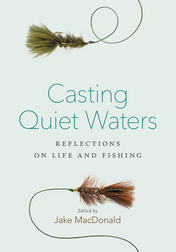Essays


It all started with the tin hat. The hat's not really made of tin, of course, just the same waxed cotton canvas under which generations of loggers have sought shelter from these endless West Coast rains. Half the time the rain is somewhere between a drizzle and a fog, a kind of heavy dew condensing on everything. The way it drips off the canopy it might as well be rain. It runs down your neck and under your flannel shirt and soaks your Queen Charlotte's tuxedo - which is what some folks around here still call their one piece Stanfields. A proper brim on a good tin hat spills the rain past the Grand Canyon of your collar.
My dad wore a hat like it almost fifty years ago on the west coast of Vancouver Island when he was laying down spruce as a gyppo contractor for Muir Brothers sawmill. His show was so haywire - and so flat busted - that when the big two-man German chainsaw broke and he couldn't afford to back order the part to fix it, he handlogged the rest of his lease to fill the contract. He filled it on time, too, even though he had to peel the spruce logs with a flat blade. But hey, a deal's a deal. Once upon a time in this country a man's word was as good as his handshake.
And my father-in-law, who preceded me through the Vancouver Sun's newsroom sixty years ago, wore a tin hat when he worked as a whistlepunk and sparkchaser for Butcher Bloedel - as Bloedel, Stewart & Welch, the forerunner of MacMillan Bloedel was once rudely called. That was before taking up newspapering so he could get married, live in town and eat a dry lunch. Whenever I drive the Island Highway now, we go through the ritual of slowing for my daughter as we pass the BC Forest Museum and offering a toot to old "One Spot," the 45-ton wood-burning Shay that once hauled the logs her grandfather helped cut.
So when this year's Christmas present turned out to be a genuine tin hat, I was pleased. Even after thirty years it takes a woman with the right stuff to know what lurks in the heart of a man. You can keep your silk ties. I'll take a tin hat every time. No true coast rat should be without one.
My hat is a Filson, purveyor of quality headgear to people who have worked outdoors since the skids on skid road referred to bunkhouse foundations rather than people's misfortunes. And let's be clear, that skid road was East Cordova in Vancouver, not Yesler Street in Seattle. Our pals to the south take credit for coining the term skid road just because Henry Yesler built one near Pioneer Square. Actually, for those who care to be accurate about such things, skid road has its etymological roots in the pre-revolutionary Royal Navy dockyards.
Anyhow, I tried on my new chapeau. But the truth is, nothing looks so forlorn as a tin hat and one of those uptown Gore-Tex squall jackets from Mountain Co-op or Eddie Bauer.
"For that jacket you need aviator shades and a cranberry baseball hat," I was informed. "For that hat you need to ditch the Gore-Tex and get a siwash sweater."
Now, before the guardians of politically correct speech take umbrage at the word siwash, let me remind everyone that until it fell into disfavour thanks to misuse by the stupid, it was a self-referential term in Chinook, the vigorous trade jargon that exemplifies the cross-fertilizing fusion of cultures that characterizes the best of this coast. My white-collar, high-ratio mortgaged colleagues from the cast are difficult to convince, but a Chinook dictionary was once as essential as CP Caps and Spelling for reporters venturing beyond the city limits. My own tattered copy was bequeathed by a predecessor who departed our vale of tears so long ago nobody remembers he was here. The dictionary was dog-eared long before it got to him. I thought of what he would say if he ran into me wearing my tin hat with my Gore-Tex jacket: "Hyas pelton, mika." Right: pretty silly.
Nope, a quality tin hat demands a quality sweater. And not one of those trim, trendy, touristy Gastown models, all chocolatecoloured reindeer leaping across snowy wool. A machine-knit imitation won't do, either. A tin hat demands a sweater that is knit from bulky hand-spun wool, the kind of sweater that will keep you warm even when you've had a good soaking. It has to be sloppily oversized and knit from coarse, lanolin-rich, rain-shedding yarn. The pattern should be a traditional grey snowflake on dirty white. And it has to be made by the right woman.
Where else to begin on a sodden winter weekend with the rivers in spate than with a spur-of-the-moment expedition to the Cowichan Valley on Vancouver Island's east coast? My wife is the guru here. Susan's family connections to the Cowichan Indian Reserve reach back almost to the First World War. She passed on to me the story of the "ool church," paid for dollar-by-dollar with shepherds' and knitters' contributions. Her practical advice: stick my nose in first at Hill's Koksilah Store and see what's on the rack.
Hill's is more than a commercial venture, it's also a rich piece of local history, one of those welcomed alternatives that helped aboriginal artists find prominence in mainstream markets outside museum collections and gift shops. Indian bands run competing retail outlets now and gone are the days when a Cowichan sweater went for $15 at the sporting goods store where you chose your spoons and Lucky Louie plugs. Old-timers liked their sweaters long. Fishing from dugouts for winter springs in Cowichan Bay, they would pull them down and squat inside a kind of tent.
Originally, Cowichan women wove cedar bark, dog hair and mountain goat wool. When Scottish crofters came as pioneers about 150 years ago, they brought sheep and knitting needles. Traditions merged. With needles fashioned
from whalebone and golden ninebark - later from telephone wire and chopsticks, today from plastic - Cowichan knitters began producing unique waterproof sweaters perfectly adapted to the coastal climate. Traditional designs ornamented sweaters prized at first by loggers, timber cruisers, hunters and deckhands on the double-enders. Today they are recognized worldwide as art.
The art went uptown, as it will, and so did Hill's, which is why most of us associate the name with that trendy gallery on Water Street in Vancouver's Gastown. But the original Koksilah store is still there, a creaky frame house with gables, an old fashioned veranda and a floor that squeaks. We arrived exactly five minutes before closing on New Year's Eve (hey, I said it was spur of the moment). Colleen McCartney - who had just become Colleen McKay - really wanted to close up. Colleen was a remarkably good sport for a woman about to leave on her honeymoon. A middle-aged guy fussing over patterns, colours and size was definitely not high on her agenda. But she let me in to look anyway. There was nothing that fit that I liked and nothing I liked that fit. But Colleen had a New Year's gift for me: a name.
Gloria Tommy has been knitting Cowichan sweaters for more than fifty years. She learned at the knee of her mother, Susan Harris, who knitted for more than sixty years and learned when she was "little little" from her mother by lantern light. Gloria's daughter Valerie knits. Granddaughters Ruby, 11, and Cecily, 8, both knit. Even her grandson David knits toques and mittens when he needs pocket money. The matriarch of this sweater-knitting dynasty - twenty-four grandchildren and five great-grandchildren - agreed to make me a sweater, properly overlength, snowflake pattern, same style as graced the backs of Dief the Chief, Bing Crosby and Prince Philip.
It took 2.2 kilos of carded wool. She tweaked it and on her own spinning wheel spun it into characteristic Cowichan yarn-one that's noted for a unique twist that gives it surprising elasticity. She used three balls of yarn the size of basketballs to knit my sweater-black and grey for the patterns, white for the background. When I collected it, we went for coffee. I told her a story about my father-in-law and a dugout canoe. She told me her father-in-law carved those dugouts, maybe even that one. Then Gloria told me quietly that she'd added a traditional wave pattern to frame my snowflakes - I hadn't asked for it, but the design wanted it. She was absolutely right. It was perfect.
What I did next was another West Coast tradition. I put on my siwash sweater and my tin hat and I went for a long walk by the river in the rain. It came down buckets, dimpling the pools where the trout were resting and hissing through the trees. When I got back, my high-tech boots with the Gore-Tex liners felt kind of soggy. The rest of me was warm and dry.








